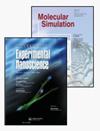Molecular dynamics and integral equation study of the structure and dynamics of solid and liquid magnesium phosphide
IF 2
4区 化学
Q4 CHEMISTRY, PHYSICAL
引用次数: 0
Abstract
ABSTRACTThe static structure and self-ionic transport in solid and molten magnesium phosphide (Mg3P2) are investigated by means of the molecular dynamics simulation and the hypernetted-chain theory of liquids using a newly developed semiempirical pairwise potential. Parameters of the potential were fitted to the lattice constant and bulk modulus, and then it was tested in NVE ensemble simulation at 300 K at which X-ray powder diffraction pattern was correctly reproduced. The static structure and the dynamics of self-ion transport were investigated in NPT simulations between 300 and 1500 K. The temperature evolution of the radial distribution functions, coordination numbers, mean square displacements, self-diffusion coefficients and solid–liquid transition were established at solid and liquid phases that will be informative for the thermoelectronic, optoelectronic and energy storage applications of the magnesium phosphide.KEYWORDS: Magnesium phosphidemodel potentialstatic and dynamic propertiesmolecular dynamics simulationhypernetted-chain theory AcknowledgmentsThe authors would like to acknowledge that this paper is submitted in partial fulfilment of the requirements for PhD degree at Yildiz Technical University.Disclosure statementNo potential conflict of interest was reported by the author(s).固态和液态磷化镁结构和动力学的分子动力学和积分方程研究
摘要采用分子动力学模拟和液体超网状链理论,利用新发展的半经验对偶势,研究了固态和熔融磷化镁(Mg3P2)的静态结构和自离子输运。将电势参数拟合为晶格常数和体模量,并在300 K的NVE系综模拟中进行了测试,得到了正确的x射线粉末衍射图。在300 ~ 1500k范围内进行了核不扩散模拟,研究了自离子输运的静态结构和动力学。建立了磷化镁在固液相的径向分布函数、配位数、均方位移、自扩散系数和固液相变的温度演化规律,为磷化镁在热电子、光电和储能等方面的应用提供了理论依据。关键词:磷化镁模型电位静态和动态特性分子动力学模拟超网状链理论致谢作者承认,这篇论文是在部分满足耶尔德兹工业大学博士学位要求的情况下提交的。披露声明作者未报告潜在的利益冲突。
本文章由计算机程序翻译,如有差异,请以英文原文为准。
求助全文
约1分钟内获得全文
求助全文
来源期刊

Molecular Simulation
化学-物理:原子、分子和化学物理
CiteScore
3.80
自引率
9.50%
发文量
128
审稿时长
3.1 months
期刊介绍:
Molecular Simulation covers all aspects of research related to, or of importance to, molecular modelling and simulation.
Molecular Simulation brings together the most significant papers concerned with applications of simulation methods, and original contributions to the development of simulation methodology from biology, biochemistry, chemistry, engineering, materials science, medicine and physics.
The aim is to provide a forum in which cross fertilization between application areas, methodologies, disciplines, as well as academic and industrial researchers can take place and new developments can be encouraged.
Molecular Simulation is of interest to all researchers using or developing simulation methods based on statistical mechanics/quantum mechanics. This includes molecular dynamics (MD, AIMD), Monte Carlo, ab initio methods related to simulation, multiscale and coarse graining methods.
 求助内容:
求助内容: 应助结果提醒方式:
应助结果提醒方式:


